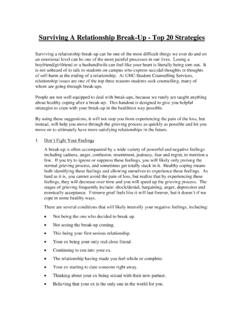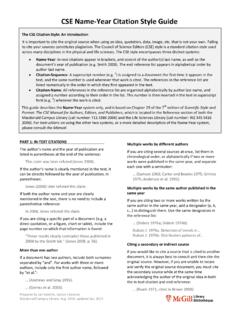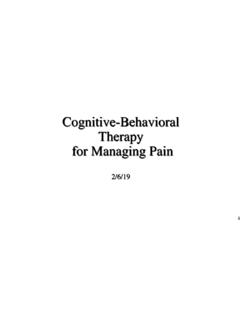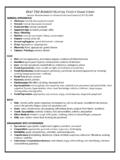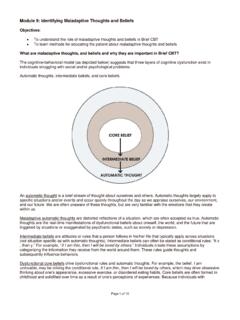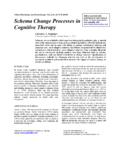Transcription of SOCIAL ANXIETY/SHYNESS - McGill University
1 SOCIAL ANXIETY/SHYNESS Identification: Almost everyone has felt nervous before a presentation, or uncomfortable in a new SOCIAL setting, which illustrates that everyone has some degree of SOCIAL anxiety. It makes the most sense seeing people on a continuum. According to a Student Life Survey (2001) done on the University of Alberta campus, 45% of the students reported that shyness has been a problem and about 50% of the students reported that they had problems with public speaking. Most people feel shy because they worry about other s perceptions of them. However, if this worry becomes persistent and disrupts daily life, leading to the use of drugs or alcohol to facilitate their SOCIAL skills, or turning down opportunities that require public speaking, they are exhibiting signs of SOCIAL anxiety disorder.
2 SOCIAL anxiety is described as a pervasive fear of SOCIAL situations in which an individual might be subjected to humiliation or scrutiny. About 20% of the general population has diagnosable SOCIAL anxiety. People with SOCIAL anxiety display a number of other common characteristics including: being overly self conscious trouble making friends or maintaining a relationship feeling anxious during SOCIAL situations/interactions excessive worry about how others will evaluate you constant need for reassurance fear that others will disagree with you fear that your own words might be offensive not feeling in control of your body fears that fit into one or both of the following categories: 1.
3 PERFORMANCE: being in public areas (washrooms, buses, malls) eating, drinking or writing in front of others participating in sports or working out with other people participating in classes or meetings public speaking 2. INTERACTION: initiating or maintaining a conversation talking on the phone talking to someone in authority (doctor, professor, boss) expressing personal opinions working in a group being in intimate situations ( dating) going to parties or other SOCIAL events SOCIAL Comfort SOCIAL Anxiety SOCIAL Phobia Page 2 SOCIAL anxiety can also be understood in terms of a number of common signs, which fit into three main categories: 1.
4 PHYSICAL: blushing sweating rapid breathing increased heart rate shaking clammy hands upset stomach dry mouth lightheadedness 2. COGNITIVE: false belief that you will be judged negatively false belief that others will not approve of you fear of embarrassment in front of others wanting to make a good impression, but doubting your ability to do so worrying about events ahead of time 3. BEHAVIOURAL: avoidance of uncomfortable situations (performance or interaction with others) passive, withdrawn use of alcohol or substances to manage situations asking for reassurance apologizing excessively avoiding eye contact wearing makeup to cover blushing Coping Strategies: 1.
5 Be Realistic About What You Are Able To Change By learning the self-help strategies in this handout, you will not become an extrovert if you have spent your life being an introvert. Instead, the hope is that you will become successfully shy as opposed to being unhappily shy. Unhappily shy people fear being judged, say as little as possible due to this fear, believe that other people don t get nervous, believe that everyone is aware of their nervousness, feel responsible for any gaps in a conversation, feel like they are a failure in many SOCIAL situations and question everything they say in SOCIAL situations. Successfully shy people feel they have interesting things to say, believe that most people are friendly and accepting, don t feel like they have to impress everyone in a SOCIAL situation, realize that just about everyone gets anxious meeting new people, realize you can t be friends with everyone, can handle silences in conversations, can admit they are nervous, have realistic expectations for SOCIAL encounters and feel okay about being a good listener.
6 Also, realize that the goal to aspire to is not to eliminate all of your anxiety, but instead to reduce it to a level that you can live with, where you can enjoy your SOCIAL interactions. (What you feel) (What you think) (What you do) Page 3 2. Remember That It May Feel Worse, Before It Gets Better Confronting your SOCIAL anxiety or shyness is difficult and this is why you have likely avoided a number of SOCIAL situations. When you begin to confront new SOCIAL situations, at first it will feel awkward or uncomfortable, but you can t let this stop you. After repeated practice, facing your anxiety provoking SOCIAL situations will definitely get easier.
7 The no pain, no gain idea fits for facing your SOCIAL anxiety, but you need to face new SOCIAL situations slowly and progressively, building on what you are already comfortable with. 3. Identifying Your negative automatic Thoughts One of the biggest problems for people with SOCIAL anxiety is that they are their own worst critics. They often have negative thoughts about themselves and their performance in SOCIAL settings that appear automatically. Such thoughts include: a) No one will ever like my presentation. b) I look like an idiot with my stammering. c) I bet they are all laughing at me behind my back. d) I can t do this, I m such a failure.
8 E) No one will ever want to be with me. To identify these negative automatic thoughts, it can be very helpful to use a log. Every time you have a negative thought about yourself in a SOCIAL context, write it down. It is also beneficial to write down the situation you were in that triggered your negative thoughts and anxiety. This method will help you identify what situations provoke your anxiety. 4. Challenge negative Thoughts After you have identified your negative thoughts, you need to begin to assess the validity of these thoughts. It is highly likely that most of your beliefs are highly exaggerated, irrational or completely untrue.
9 You can discover the distortions in your thinking by asking yourself some of the following questions: What is the evidence that supports my fear? Do other people actually notice my nervousness? What is the worst possible thing that could happen? Will that mistake ruin all prospects of my future? Am I 100% sure that others think that way about me? What are the odds of that particular situation happening? I probably do not possess fortune-telling abilities, so how do I know what will happen in the future? Will that situation happen to the extent I fear? Maybe I am exaggerating the risk? Would I ever treat a friend the way I m treating myself?
10 What would a confident person do in the same situation? Will any of this matter a year from now? Could there be other explanations for their behavior? Page 4 5. Identifying Cognitive Distortions People with SOCIAL anxiety have a different mindset compared with confident individuals. Underlying your negative automatic thoughts is usually a set of faulty and unhelpful beliefs. By identifying the distortions in your thinking, you can begin to understand the source of your anxiety. Typical cognitive distortions include: a) Perfectionism you set impossible goals for yourself in SOCIAL situations and end up feeling like a failure.
